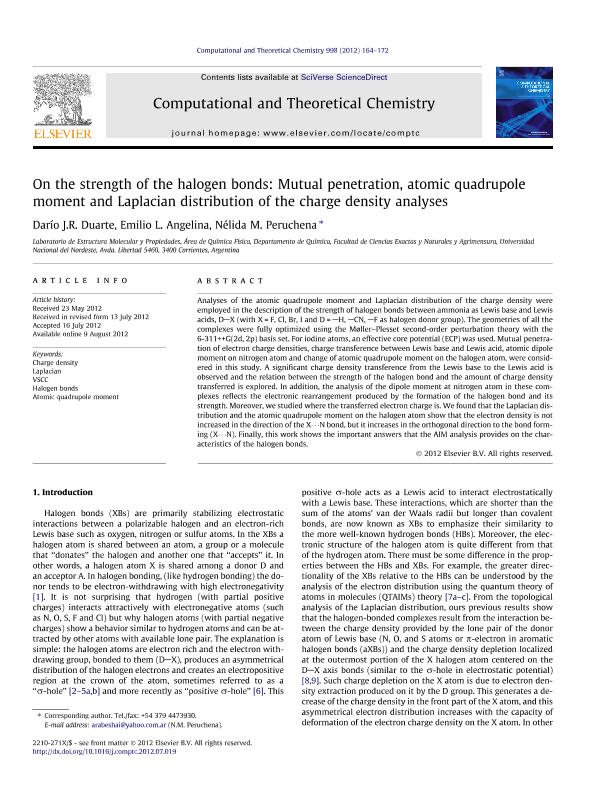Mostrar el registro sencillo del ítem
dc.contributor.author
Duarte, Darío Jorge Roberto

dc.contributor.author
Angelina, Emilio Luis

dc.contributor.author
Peruchena, Nelida Maria

dc.date.available
2023-07-26T19:56:09Z
dc.date.issued
2012-10
dc.identifier.citation
Duarte, Darío Jorge Roberto; Angelina, Emilio Luis; Peruchena, Nelida Maria; On the strength of the halogen bonds: Mutual penetration, atomic quadrupole moment and Laplacian distribution of the charge density analyses; Elsevier; Computational and Theoretical Chemistry; 998; 10-2012; 164-172
dc.identifier.issn
2210-271X
dc.identifier.uri
http://hdl.handle.net/11336/205728
dc.description.abstract
Analyses of the atomic quadrupole moment and Laplacian distribution of the charge density were employed in the description of the strength of halogen bonds between ammonia as Lewis base and Lewis acids, D. X (with X = F, Cl, Br, I and D = H, CN, F as halogen donor group). The geometries of all the complexes were fully optimized using the Møller-Plesset second-order perturbation theory with the 6-311++G(2d, 2p) basis set. For iodine atoms, an effective core potential (ECP) was used. Mutual penetration of electron charge densities, charge transference between Lewis base and Lewis acid, atomic dipole moment on nitrogen atom and change of atomic quadrupole moment on the halogen atom, were considered in this study. A significant charge density transference from the Lewis base to the Lewis acid is observed and the relation between the strength of the halogen bond and the amount of charge density transferred is explored. In addition, the analysis of the dipole moment at nitrogen atom in these complexes reflects the electronic rearrangement produced by the formation of the halogen bond and its strength. Moreover, we studied where the transferred electron charge is. We found that the Laplacian distribution and the atomic quadrupole moment on the halogen atom show that the electron density is not increased in the direction of the X...N bond, but it increases in the orthogonal direction to the bond forming (X...N). Finally, this work shows the important answers that the AIM analysis provides on the characteristics of the halogen bonds.
dc.format
application/pdf
dc.language.iso
eng
dc.publisher
Elsevier

dc.rights
info:eu-repo/semantics/openAccess
dc.rights.uri
https://creativecommons.org/licenses/by-nc-nd/2.5/ar/
dc.subject
ATOMIC QUADRUPOLE MOMENT
dc.subject
CHARGE DENSITY
dc.subject
HALOGEN BONDS
dc.subject
LAPLACIAN
dc.subject
VSCC
dc.subject.classification
Físico-Química, Ciencia de los Polímeros, Electroquímica

dc.subject.classification
Ciencias Químicas

dc.subject.classification
CIENCIAS NATURALES Y EXACTAS

dc.title
On the strength of the halogen bonds: Mutual penetration, atomic quadrupole moment and Laplacian distribution of the charge density analyses
dc.type
info:eu-repo/semantics/article
dc.type
info:ar-repo/semantics/artículo
dc.type
info:eu-repo/semantics/publishedVersion
dc.date.updated
2023-06-28T15:08:50Z
dc.journal.volume
998
dc.journal.pagination
164-172
dc.journal.pais
Países Bajos

dc.description.fil
Fil: Duarte, Darío Jorge Roberto. Universidad Nacional del Nordeste. Facultad de Ciencias Exactas y Naturales y Agrimensura. Departamento de Química. Laboratorio de Estructura Molecular y Propiedades; Argentina. Consejo Nacional de Investigaciones Científicas y Técnicas; Argentina
dc.description.fil
Fil: Angelina, Emilio Luis. Universidad Nacional del Nordeste. Facultad de Ciencias Exactas y Naturales y Agrimensura. Departamento de Química. Laboratorio de Estructura Molecular y Propiedades; Argentina. Consejo Nacional de Investigaciones Científicas y Técnicas; Argentina
dc.description.fil
Fil: Peruchena, Nelida Maria. Universidad Nacional del Nordeste. Facultad de Ciencias Exactas y Naturales y Agrimensura. Departamento de Química. Laboratorio de Estructura Molecular y Propiedades; Argentina. Consejo Nacional de Investigaciones Científicas y Técnicas; Argentina
dc.journal.title
Computational and Theoretical Chemistry
dc.relation.alternativeid
info:eu-repo/semantics/altIdentifier/doi/http://dx.doi.org/10.1016/j.comptc.2012.07.019
Archivos asociados
